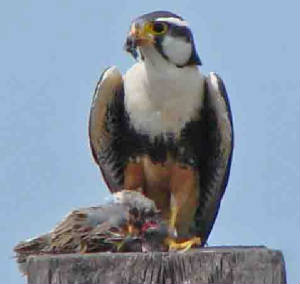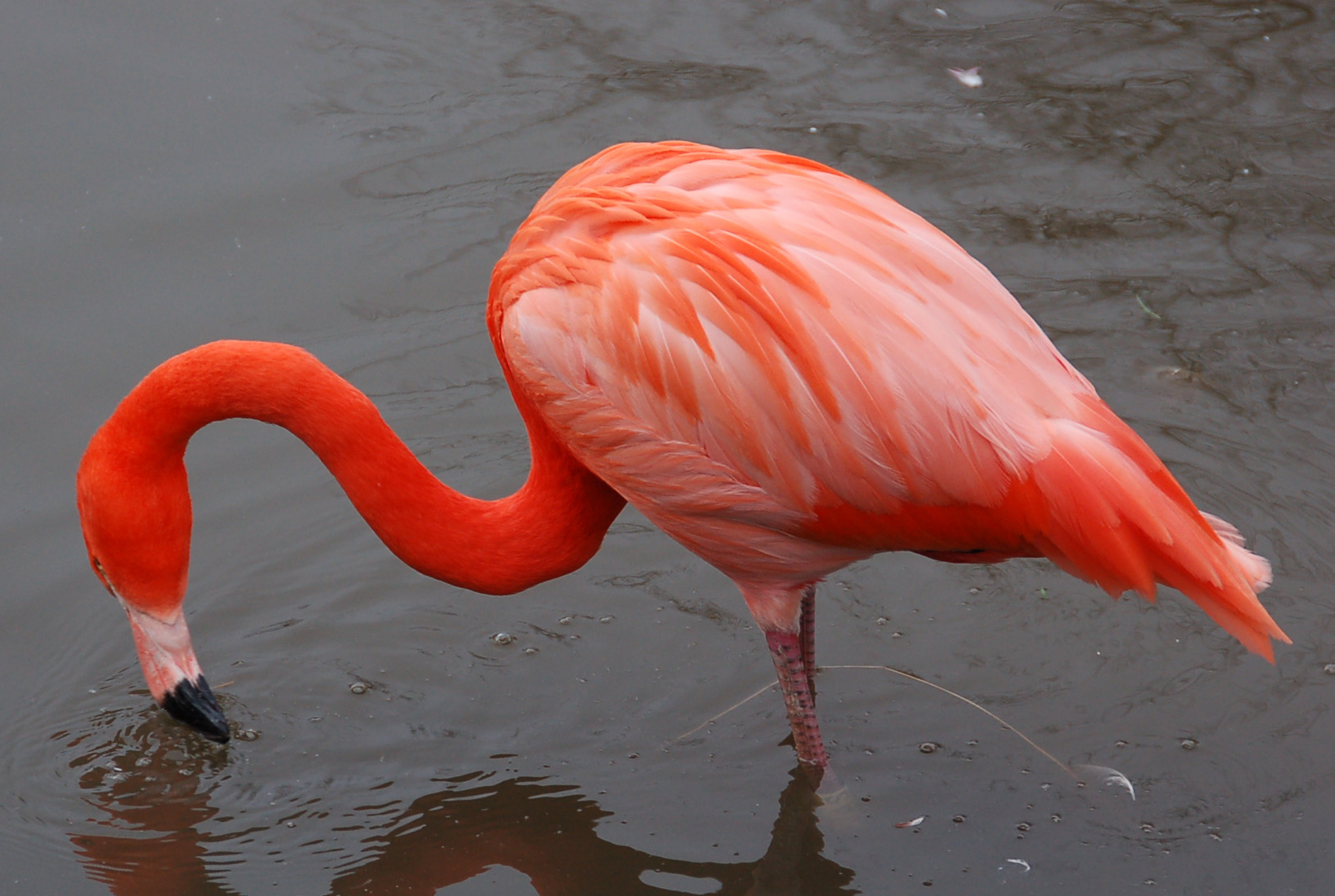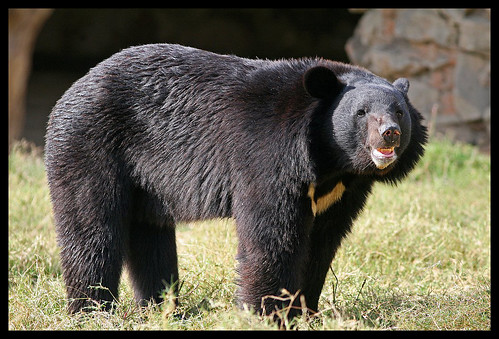
The Aplomado Falcon's habitat is dry grassland
Grassland
Grasslands are areas where the vegetation is dominated by grasses and other herbaceous plants . However, sedge and rush families can also be found
s, savanna
Savanna
A savanna, or savannah, is a tropical, subtropical or temperate woodland ecosystem characterized by the trees being sufficiently small
or widely spaced so that the Canopy does not close
hs, and marsh
Marsh
In geography, a marsh, or morass, is a type of wetland which is subject to frequent or continuous flood .
Typically the water is shallow and features Poaceaees, Juncaceaees, Phragmites, typhas, Cyperaless, and other herbaceous plants
es. It ranges from northern Mexico
Mexico
The United Mexican States , commonly known as Mexico , is a federalism constitutionalism republic in North America. It is bordered on the north by the United States; on the south and west by the Pacific Ocean; on the southeast by Guatemala, Belize, and the Caribbean Sea; and on the east by the Gulf of Mexico
and Trinidad
Trinidad
Trinidad is the larger and more populous of the two major islands and islands of Trinidad and Tobago which make up the country of Trinidad and Tobago....
locally to southern South America
South America
South America is the southern continent of the Americas, situated entirely in the Western Hemisphere and mostly
in the Southern Hemisphere, with a relatively small portion in the Northern Hemisphere....
, but has been extirpated
Local extinction
Local extinction is where a species ceases to exist in the chosen area of study, but still exists elsewhere.
This phenomenon is also known as extirpation....
from many places in its range, including all of northern and central Mexico except for a small area of Chihuahua. Globally, however, it is so widespread that it is assessed as Species of Least Concern
Least Concern
Least Concern is an
World Conservation Union category assigned to extant species or lower taxa which have been evaluated but do not qualify for any other category....
by the IUCN.
It feeds on large invertebrate
Invertebrate
An invertebrate is an animal lacking a vertebral column.
The group includes 98% of all animal species ? all animals except those in the Chordate subphylum vertebrate ....
s and small vertebrate
Vertebrate
Vertebrates are members of the subphylum Vertebrata, chordates with Vertebras or Vertebral columns. The grouping sometimes includes the hagfish
which have no vertebrae, but are genetically quite closely related to lampreys
which do have vertebrae....
s, with small birds making up the overwhelming bulk of its prey. Mixed-species feeding flock
Mixed-species feeding flock
A mixed-species feeding flock, mixed-species foraging flock or mixed hunting party is a Flock of birds of different species, often of different feeding guilds
that join each other to search for food....
s in open cerrado
Cerrado
The cerrado is a vast tropical savanna ecoregion of Brazil.
The cerrado is characterised by an enormous range of plant and animal biodiversity....
and grassland will go on frenzied alert upon spotting this species; small birds fear it more than most other predators.
It is often seen soaring at twilight hunting insect
Insect
Insects are the biggest class of arthropods and the only ones with wings.
They are the most diverse group of animals on the planet. They are most diverse at the equator and their diversity declines toward the poles....
s and eating them on the wing. It also hunts at fields being burned, at which many birds of this species may gather; cooperation between individual Aplomado Falcons – usually members of a pair – has also been recorded. In Brazil
Brazil
Brazil , officially the Federative Republic of Brazil , is a country in South America.
It is the List of countries and outlying territories by total area country by geographical area, occupying nearly half of South America, the List of countries by population country, and the fourth most populous democracy in the world
, Aplomado Falcons have been observed following Maned Wolves
Maned Wolf
The Maned Wolf is the largest canidae of South America, resembling a big fox with reddish fur.This mammal is found in
open and semi-open habitats, especially grasslands with scattered
bushes and trees, in south-eastern Brazil , Paraguay, northern Argentina, Bolivia east and north of the Andes, and far south-eastern Peru
(Chrysocyon brachyurus) and chasing birds that the wolves flush. Prey items typically weigh one-fifth to one-half of the falcons' own weight, but females of this species
(which due to their size can tackle larger prey) have been recorded eating birds larger than themselves, such as a Cattle Egret
Cattle Egret
The Cattle Egret is a cosmopolitan distribution species of heron found in the tropics, subtropics and warm temperate zones.
It is the only member of the monotype genus Bubulcus, although some authorities regard its two subspecies as full species....
(Bulbucus ibis) or a Plain Chachalaca
Plain Chachalaca
The Plain Chachalaca, Ortalis vetula is a large bird in the Cracidae family.
It breeds in tropical and subtropical environments from the chaparral thickets in the Rio Grande Valley in southernmost Texas, United States to northernmost Costa Rica....
(Ortalis vetula), on rare occasions.
The nest is a platform built of sticks at any height in a bush or tree. Two or three eggs are laid.
Until the 1950s it was found in the extreme southwestern United States
United States
The United States of America is a Federal government constitutional republic comprising U.S. state and a federal district.
The country is situated mostly in central North America, where its Contiguous United States and Washington, D.C., the Capital districts and territories
lie between the Pacific Ocean and Atlantic Oceans, Borders of the U...
, and reintroduction efforts are under way in Western and Southern Texas
Texas
Texas is a U.S. state located in the South Central United States, nicknamed the Lone Star State. Texas is the second largest U.S. state in both area and population
spanning , and with a growing population of 24.3 million residents....
. It began to reoccupy its former range in West Texas and southern New Mexico
New Mexico
New Mexico is a U. S. State located in the Southwestern United States of the United States. Inhabited by Native Americans in the United States populations for many centuries, it has also has been part of the Spanish Empire viceroyalty of
New Spain, part of Mexico, and a U.S....
in the 1990s. Documentary evidence for these naturally occurring birds was obtained in New Mexico in 1991, and sightings built steadily through that decade and the next, leading to successful fledging
Fledge
Fledge is the stage in a young bird's life
when the feathers and wing muscles are sufficiently developed for flight.
It also describes the act of raising chicks to a fully grown state by the chick's parents....
of three young in 2002. Sightings and nesting activity continue to the present.
The expansion of the reintroduction program to that area has met with criticism, because technically, all Aplomado Falcons in
New Mexico are classified as part of the "experimental" (reintroduction) population.
As such, while they are still legally protected from hunting, they are not protected by Endangered Species Act
Endangered Species Act
The Endangered Species Act of 1973 or ESA is the most wide-ranging of the dozens of United States environmental laws passed in the 1970s....
requirements to preserve habitat and the like. It is believed that mainly habitat destruction
Habitat destruction
Habitat destruction is the process in which natural habitat
is rendered functionally unable to support the species originally present. In this process, plants and animals which previously used the site are displaced or destroyed, reducing biodiversity
caused the species' (near-)disappearance from the US and hinders reestablishment of a wild breeding population.
A coalition of environmental groups is attempting to have
full protection restored so as not to jeopardize the success of the expanding wild population and the reintroduction efforts.















































